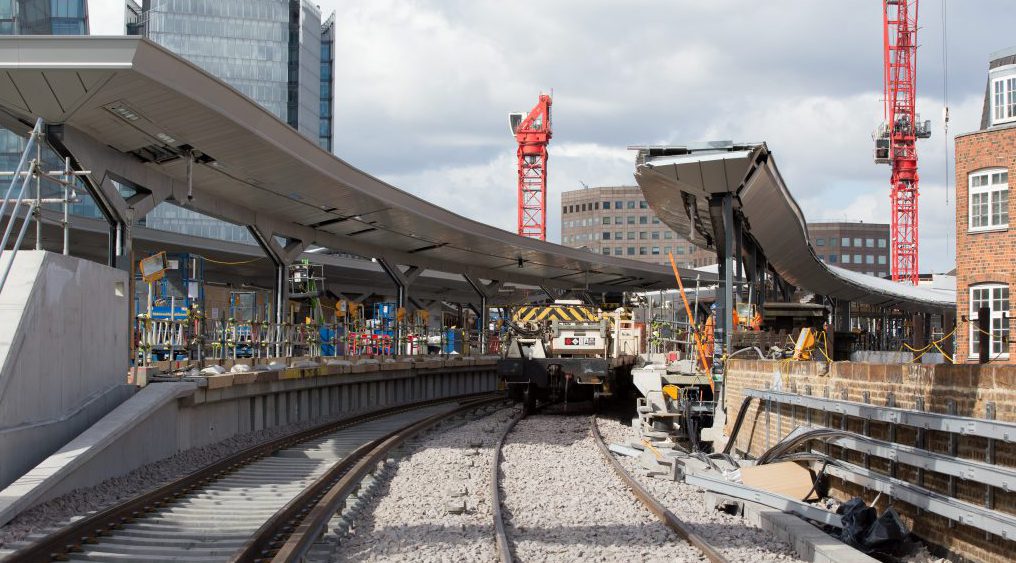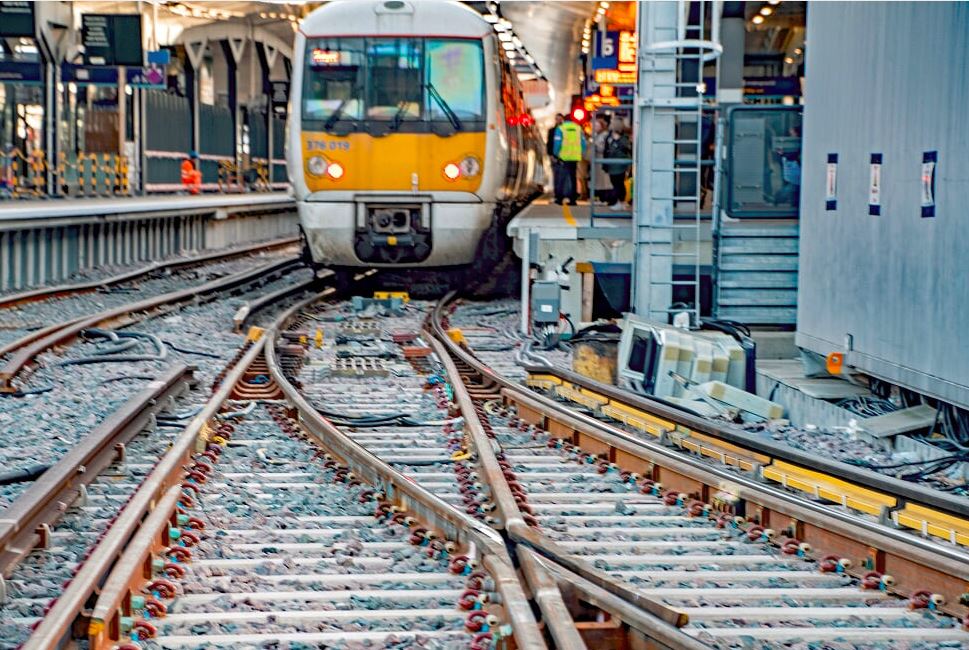London Thameslink railway works gain CEEQUAL Excellent
Overview
This project included track, signalling and civils works around London Bridge Station, covering 7 km of infrastructure between Charing Cross and New Cross. It spanned three London Boroughs with significant potential impact on local communities. This project achieved significant sustainability outcomes, securing a CEEQUAL (now known as BREEAM Infrastructure) rating of Excellent.
About
Network Rail is the organisation which owns, repairs and develops the railway infrastructure in England, Scotland and Wales. Its remit includes over 20,000 miles of track - including the stretch in London where this project took place.
Background
The Government-sponsored £7bn Thameslink Programme was an ambitious 10-year programme to transform north-south travel through London. It included extensive infrastructure enhancements and the delivery of 115 new trains. It has brought faster, more frequent, more reliable and better connected journeys for passengers.
As part of this programme, the London Bridge Railway Systems project included track, signalling and civils works through and around London Bridge Station, and had a project value of £530 million. Balfour Beatty Rail (BBR) was the main contractor for significant track remodelling, electrification and minor civil engineering works, Siemens Rail Automation (SRA) was the appointed signalling contractor, and Network Rail (NR) the client. The Railway Systems works supported the redevelopment of London Bridge Station which was a major bottleneck and the lynchpin of the TLP.
Key Output 2 of the London Bridge Railway Systems project began in 2013, with works completed in 2019. Sustainability was a key driver throughout the project, with contractors tracking progress against TLP Sustainability Strategy targets. The project captured many best practices and lessons learnt to share with the wider industry.
Challenges
There were restrictions on the materials which could be used as part of the project due to the detailed and specific nature of the Bill of Materials, and also the need to use pre-approved Network Rail materials, components and suppliers. This made it challenging to work towards material use targets on responsible sourcing such as recycled content and use of local suppliers. Despite this, SRA completed a ‘deep dive’ responsible sourcing case study, where the cable supply chain was investigated and mapped. BBR also explored various resource efficiency options in order to reduce waste and embodied carbon.
Solutions
The TLP valued sustainability as an important indicator of overall success; multiple projects on the programme completed CEEQUAL assessments. CEEQUAL encouraged consideration of sustainability throughout the project. The TLP Sustainability Strategy identified the programme-wide sustainability objectives and targets. It achieved high scores in many areas of the assessment.
People and communities
Skills and employment: Section 106 requirements
To secure planning permission for the London Bridge Station Redevelopment works, a Section 106 agreement was determined as an obligation by Southwark Council, under the 1990 Town and Country Planning Act. In this case, the Section 106 required certain Employment, Skills & Training (EST) targets to be achieved as part of the planning permission, to ensure that the development was acceptable. This included the contractors involved on the Railway Systems part of the project – BBR and SRA.
The aim of the TLP Section 106 was to ensure development benefitted the local community. This was appropriated through improving skills and providing employment opportunities. BBR met all their Section 106 requirements, including retaining 11 previously unemployed residents and supporting 8 new apprentices. This can be attributed to early and consistent engagement with project teams/ senior management/ subcontractors. Senior leadership buy-in was a key factor.
Notifying residents: Section 61s
An effective section 61 application procedure was established at the start of the project, which ensured the contractors were operating within a consent. A collaborative approach meant that BBR, the principal contractor, led on Section 61 applications, liaising with councils and notifying residents. This was key given the large geographical area of the project, the nature of the works, and the densely populated urban areas with sensitive communities. Although noise complaints were received, effects on the community were generally mitigated through good community management and excellent relationships with the local authorities.
Community engagement events
There was an established community engagement programme throughout the project. Contractors worked both in collaboration with each other, NR, and independently. In particular there have been various STEM (Science, Technology, Engineering and Maths) events which aimed to utilise contractor skillsets to inspire tomorrow’s workforce. Engagement events were organised throughout the programme, ensuring the maximum number of individuals could be reached. Examples included events with the Engineering Development Trust, visits to various local schools, hosting stands at careers fairs such as the Southwark Educational Business Alliance Careers Fair, school open days at the project offices focusing on rail or engineering, mentoring programmes, volunteering & donating, and careers talks.
BBR led 54 school engagement events and 37 fundraising events (raising over £11,000 for charity). SRA led and supported 74 community engagement events over the TLP. It is estimated that more than 800 students were reached through SRA’s STEM / career engagement initiatives since 2016. It should be noted that the event figures given above overlap given many of the events were completed collaboratively between the two contractors, and with the support and input of NR.
Such extensive engagement can be attributed to dedicated staff who were committed to enhancing sustainability outcomes and who were critical to delivering community engagement initiatives.
The London Bridge Railway Systems project achieved an ‘Excellent’ score in the Considerate Constructors Scheme (CCS) each year from 2013 to 2016, and achieved an ‘Exceptional’ score in 2017.
Physical resources use and management (energy, water, materials and waste)
A voluntary workshop with Waste & Resources Action Programme (WRAP) was carried out with NR, BBR, and SRA, which targeted design efficiency. The workshop focused on designing-out waste and implementing resource efficiency. An independent best practice workshop was then completed regularly which progressed and captured initiatives used on the project.
Over the course of the programme, a variety of best practice case studies were produced by the contractors which demonstrated resource efficiency:
Reducing concrete used in 18 trackside REBs, saving 46 tonnes of concrete;
Re-use of signal structures – reduced the need for concrete and steelwork, including the elimination of the need for 3 new cantilever structures;
There were 26 new gantries or cantilevers installed, and 14 previously used installed. This meant of all gantries, 40% were reused;
Out of all routeworks completed, nearly half was refurbishment of existing route, rather than installation of new route;
Re-use of nearly 2,500m of conductor rail, saving 74 tonnes of carbon;
Use of innovative folding signal post over a traditional design saved 18,000 kg of galvanised steel, equivalent to 28 tonnes of carbon;
Implementation of double cloak signage (to facilitate the different commissioning stages) reduced waste;
Replacing the usual cast iron individual numbers used for marking Points, to a product made from 100% recycled plastic bottle tops;
Use of Class II cables over Class I cables (reduction in raw materials and embodied carbon);
Recycling flux shields on Automatic Warning System (AWS) magnets, saving 1,080kg of steel, which was equivalent to an embodied carbon reduction of 1,480 kgCO2e; and
Use of new integrated lockout devices resulted in less materials required in production and transportation of the device, and estimated embodied carbon saving of 5,546 kgCO2e.
Transport
For the track works, prefabricated track components and other materials were all delivered to site by train. At design stage, rail was considered the most sustainable method of transport.A lot of material was brought into the work sites by train and a lot of the redundant material / waste was removed in the same wagons.
This reduced the need to use roads for delivery thereby reducing carbon emissions and improving road safety.


Benefits
One of the objectives within the Strategy was for the London Bridge Railway Systems project to achieve a CEEQUAL Term Contracts score of ‘Very Good’. The team is extremely pleased to have surpassed this target by achieving Excellent.
The regular reviews required as part of the CEEQUAL Term Contracts Assessment encouraged ongoing consideration of sustainability and innovation each year of the project.
Summary
Nigel Sagar, Skanska
Andy Barnes/Emma Burrell, Schofield Lothian
